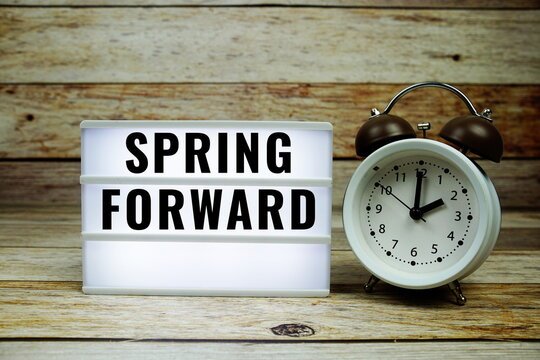As we move into 2025, one of the most anticipated seasonal events in many parts of the world is the shift to daylight saving time (DST). Commonly known as “Spring Forward,” this annual time change affects millions of people, adjusting clocks one hour ahead to make better use of daylight. This tradition has both benefits and drawbacks, impacting sleep patterns, energy consumption, and daily routines.
When is Spring Forward 2025?

Spring Forward 2025 will occur on Sunday, March 9, 2025, at 2:00 AM local time in most areas that observe daylight saving time. This means clocks will move forward by one hour, resulting in an extra hour of daylight in the evening and one less hour of sleep that night. The transition marks the start of longer daylight hours, providing more time for outdoor activities and productivity.
Why Do We Spring Forward?
Daylight saving time was introduced to make better use of daylight during the longer days of spring and summer. The idea is to reduce energy consumption and encourage outdoor activities in the evening. However, DST is not observed everywhere—some regions, such as Arizona (excluding the Navajo Nation) and Hawaii, do not participate in the time change. While the time change can help businesses by extending daylight hours for commerce, it also comes with some controversy regarding its effectiveness in modern society.
How to Prepare for the Time Change
Adjusting to the time change can be challenging, as losing an hour of sleep may disrupt your routine. Here are some tips to help your body adapt:
- Gradual Adjustment: Start going to bed 15-30 minutes earlier in the days leading up to the time change to ease the transition.
- Morning Sunlight: Spend time outside in the morning to help regulate your body’s internal clock and make the adjustment smoother.
- Limit Evening Screen Time: Reduce exposure to screens before bed, as blue light from electronic devices can interfere with melatonin production and delay sleep onset.
- Stay Active: Engage in physical activity during the day to improve sleep quality and help your body adjust more quickly to the new schedule.
- Maintain a Consistent Schedule: Try to wake up and go to sleep at the same time each day, even on weekends, to reinforce a healthy sleep cycle.
Effects of Spring Forward
Health Impacts
Studies show that losing an hour of sleep can lead to temporary fatigue, decreased concentration, and even a slight increase in heart-related health risks. Research has indicated that there is a small rise in heart attacks, strokes, and workplace accidents in the days following the time change. Additionally, individuals who already struggle with sleep deprivation may experience exacerbated symptoms, making it essential to prioritize rest and hydration.
Impact on Productivity and Daily Life
The time change affects everything from transportation schedules to digital clocks and appliances. Be sure to check your devices and manually update those that do not adjust automatically. Additionally, workplaces may experience a dip in productivity as employees adjust to the lost hour of sleep. Studies have shown that workplace errors and road accidents tend to spike immediately following the shift to daylight saving time, underscoring the importance of careful planning and self-care.
Economic and Environmental Considerations
One of the primary reasons for implementing daylight saving time was to reduce energy consumption by taking advantage of extended daylight hours. While studies show mixed results regarding actual energy savings, businesses that rely on evening foot traffic, such as restaurants and retail stores, may benefit from more consumer activity during longer daylight hours. On the other hand, increased air conditioning use in warmer climates might offset any potential savings in electricity costs.
The Future of Daylight Saving Time
In recent years, debates over the benefits and drawbacks of daylight saving time have intensified. Some lawmakers have proposed making daylight saving time permanent to eliminate the need for biannual clock changes. The Sunshine Protection Act, a bill introduced in the U.S. Congress, aims to keep daylight saving time year-round, eliminating the disruptions caused by shifting clocks twice a year. While no federal legislation has been passed yet, several states have expressed support for such measures, highlighting growing public interest in reevaluating the practice.
International Perspectives on DST
While many countries still observe daylight saving time, several nations have discontinued the practice, citing minimal energy savings and negative impacts on health and productivity. The European Union has considered abolishing DST altogether, allowing individual countries to decide whether to stay on standard time or daylight saving time permanently. As more research emerges, the global approach to time changes may continue to evolve in the coming years.
How to Make the Most of the Extra Daylight
While losing an hour of sleep may be inconvenient, there are several ways to take advantage of the extra daylight:
- Outdoor Activities: Longer daylight hours provide more opportunities for hiking, biking, and other recreational activities.
- Social Gatherings: Enjoy barbecues, outdoor dining, and community events that extend into the evening.
- Increased Productivity: Use the extended daylight to complete outdoor projects, exercise, or pursue hobbies after work.
By making small adjustments and embracing the positive aspects of daylight saving time, you can make the most of Spring Forward 2025 and enjoy a brighter, more productive season.
Final Thoughts
Spring Forward 2025 is an important seasonal shift that signals the arrival of longer daylight hours and the transition into warmer months. While the time change comes with some temporary disruptions, proper planning can ease the transition. As discussions about the future of daylight saving time continue, it remains an evolving aspect of modern life. Whether you love or dislike the clock change, one thing is certain—brighter evenings are ahead!






